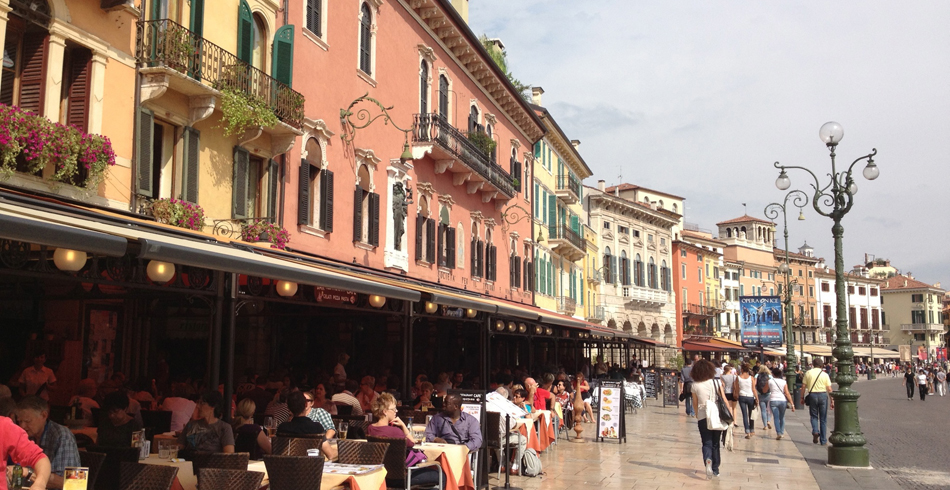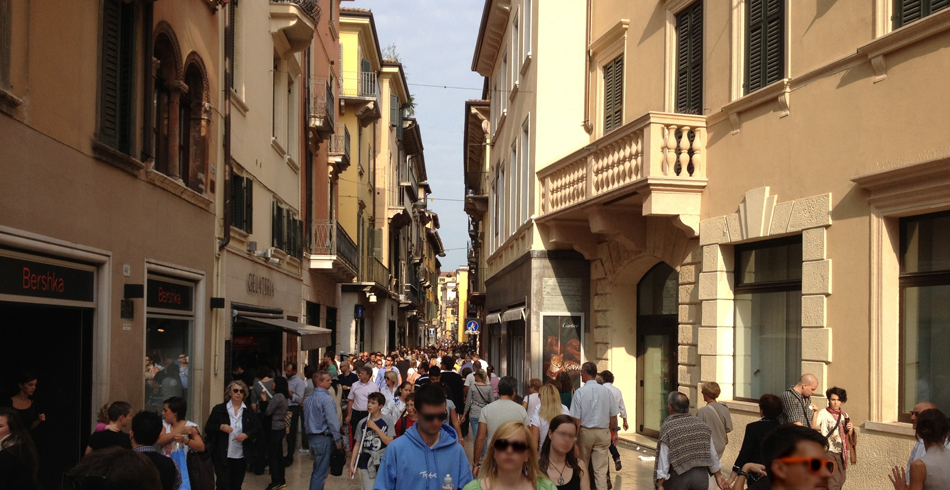Alfa Romeo and Juliet

I recently visited Verona, Italy, halfway between Milan and Venice, to learn more about designing with stone and the Italian stone trade. The Italian stone industry is centered in and around Verona, and has kept a lot of people gainfully employed during the economic downturn in Europe. Since the Romans made it an official colony in 89 BC, Verona has leveraged its’ geographical and petrological blessings into wealth and power, despite the distractions of being continuously overrun by foreign and not-so-foreign invaders.
A famous Brit named William Shakespeare wrote three plays set in Verona: The Taming of the Shrew, The Two Gentlemen of Verona, and Romeo and Juliet. Romeo and Juliet is the iconic and tragic love-story, and it lures tourists by the thousands to this beautifully preserved medieval Italian city, culminating in a pilgrimage to a four-hundred year old stone house that some genius chamber-of-commerce-type christened as the Casa di Julietta. Befitting the most important shrine to Teenage Love, the votive offering of choice most commonly left behind are notes to Juliet affixed to the exterior wall of the building with bubble gum.
If Romeo and Juliet is the gateway drug for the city of Verona, then what compelled Caesar to spend his summer vacations there 1500 years before Shakespeare was born, and what other attractions and lessons does this beautiful city have to offer for both the tourist and urban design junkie like me?
Among the remains of the Roman city of Pompeii, there is a clay tile still mounted on a wall at the forum, which depicts two merchants (or deliverymen) carrying their goods in vases. The message is clear: deliveries to the rear. The ancient Roman tradition of banning the congestion and chaos of traffic out of what has historically been public spaces for people, has seen its’ ups and downs. Automobiles are relative new-comers to cities, and are definitely the party-crashers to some of the best people spaces in the world.
Fast-forward about two millennia to the year 2000 AD, and the city of Verona is named a UNESCO World Heritage Site because of its many historic buildings, including preserved Roman monuments, medieval churches and civic buildings, and many Romanesque churches that were built after a devastating earthquake in 1117 AD. Verona more recently banned automobile traffic from a large swath of the Centro, and the results are magical. A strong bicycle culture permeates the historic center of the city, and on a balmy September weekend, I observed entire families of Scaligeri (the preferred title for the natives), couples, Nonas and children traversing the alleys and streets on their biccicletti. Unlike the brutal, all-basalt cobbles of the typical Roman strada, many streets in Verona are paved with a smooth stripe of their famous pink and white limestone, which allows bicyclists to ride smoothly without knocking their fillings out.
Removing the fear of getting run down by an Alfa during one’s Passegiata (the Italian tradition of taking a casual stroll through public spaces and shopping streets) goes a long ways toward fostering community, promoting exercise and stimulating the local economy. This is “Old Urbanism,” and it works. People-scaled streets, free of cars, allows residents and tourists alike to experience all of those wonderful things that designers and developers spend lots of time and money trying to recreate: that magical urban density that fosters a healthy and diverse mix of physical, social, cultural and commercial experiences that binds us together as neighbors and friends of a shared home.
Old Urbanism, Verona-style, is not about medieval towers, beautiful balconies, and Italian palazzi (but they are molto bello). The fact that Verona is a beautifully preserved city with buildings and monuments spanning two millennia is just frosting on the cake cinnamon on my cappuccino. The best thing about walking around a city such as this, is the fact that I can hear all the conversations around me because there are no cars whizzing by. I can have a conversation with a friend on the street without shouting, or with someone waving down at me from a balcony (Ciao, Julietta!). There is no better way to build a strong community than to get to know your neighbors, and better still, pop into their gelateria or forno and buy some ice cream or bread. Civitas is the glue of Western Civilization, so don’t take it for granted. Insist on fewer Alfa Romeos and more Juliettas.
Kevin Killen, AIA, LEED® AP, BD+C
Director of the Residential Studio, Senior Associate



